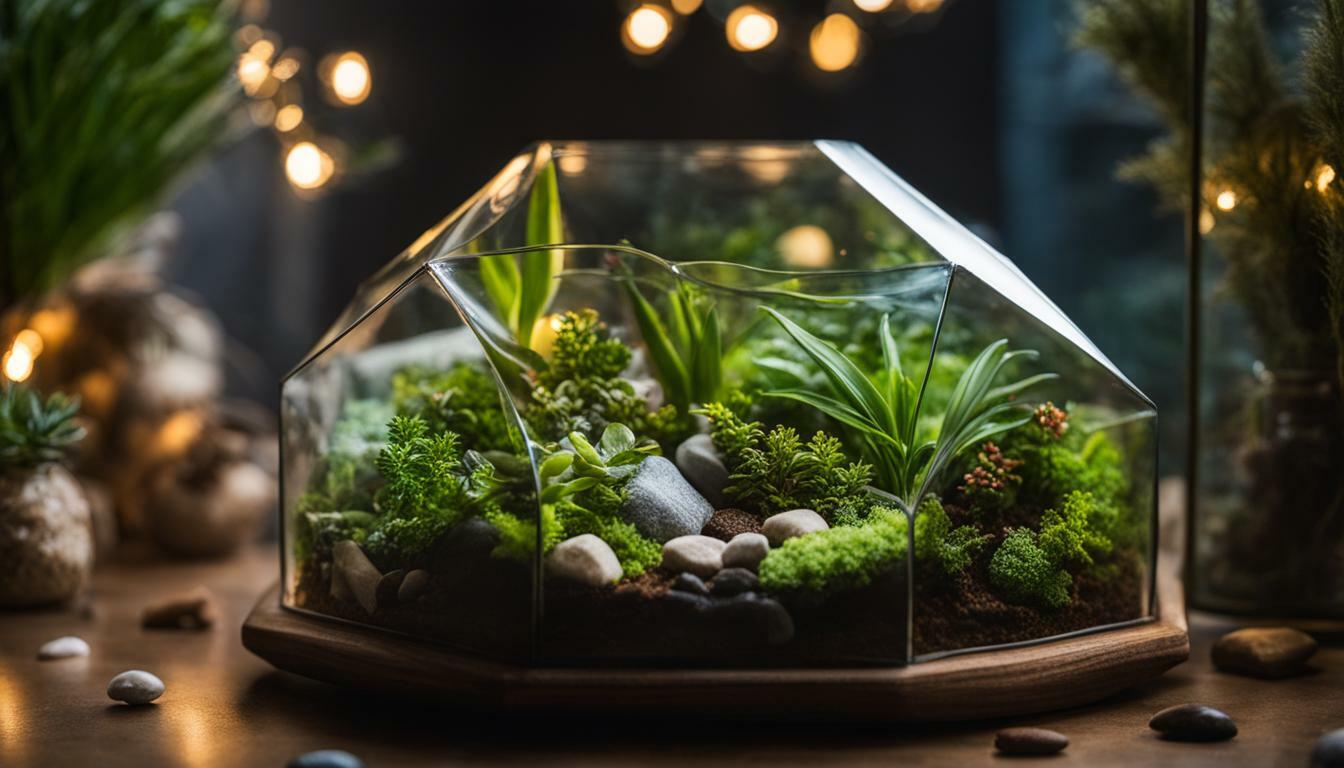Terrarium care decorations cleaning is an essential aspect of maintaining a vibrant and healthy mini eco-system. Terrariums are sealed glass containers filled with plants and soil, creating a self-contained ecosystem. Not only do they require little upkeep, but they also offer unique mental health benefits, bringing a touch of nature into our indoor spaces.
- Building a proper soil base with layers of gravel, charcoal, and moist soil is crucial for a successful terrarium.
- Selecting small, slow-growing, humidity-loving plants with vibrant colors and textures is essential for an aesthetically pleasing terrarium.
- Place your terrarium in a location with bright, indirect sunlight and maintain a consistent room temperature.
- Proper watering is vital to prevent rot and mold, as excess water can be detrimental to the health of your terrarium.
- Regular cleaning of the terrarium glass with a damp cloth ensures proper light exposure and a clear view of the plants.
In this comprehensive guide, we will delve into the various aspects of terrarium care decorations cleaning, providing you with valuable tips and techniques to master the art of maintaining a thriving terrarium. From understanding the fundamentals of terrariums to selecting suitable decorations, optimizing the environment, and troubleshooting common issues, we will cover it all. So, let’s embark on this journey together and unlock the secrets of terrarium care decorations cleaning.
Understanding Terrariums: A Brief Introduction
Terrariums are sealed glass containers filled with plants and soil, creating a mini eco-system that requires minimal upkeep. These miniature gardens have gained popularity in recent years, not only for their aesthetic appeal but also for the unique benefits they offer. Acting as self-contained ecosystems, terrariums create a harmonious balance between plants and their environment, making them an excellent addition to any indoor space.
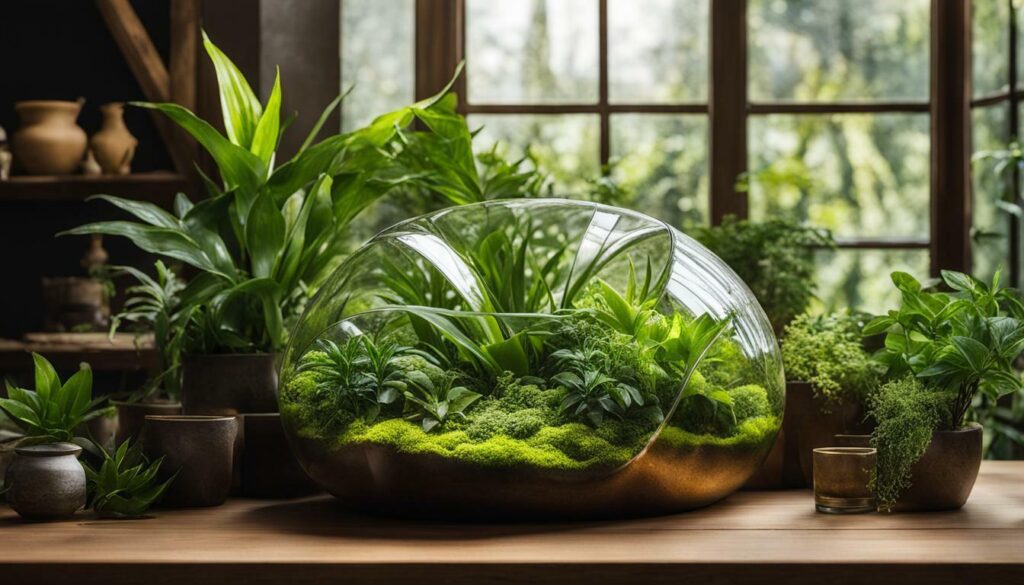
Benefits of Terrariums
One of the key benefits of terrariums is their ability to create a soothing and calming atmosphere. The presence of plants has been scientifically proven to reduce stress, improve mood, and increase productivity. By bringing nature indoors, terrariums provide a connection to the natural world, even in urban environments.
Another advantage of terrariums is their low maintenance requirements. Once properly set up, these miniature ecosystems can thrive for extended periods without frequent watering or monitoring. With their self-sustaining nature, terrariums are an ideal choice for those with limited time or gardening experience.
Building a Terrarium
When constructing a terrarium, it is crucial to create a proper soil base. Start with a layer of gravel at the bottom to ensure proper drainage. Next, add a layer of activated charcoal to filter the water and prevent odors. Finally, top it off with moist soil, providing a foundation for the plants to grow.
| Materials | Instructions |
|---|---|
| Glass container | Choose a clear glass container to allow for maximum visibility. |
| Gravel | Add a layer of gravel for drainage at the bottom of the container. |
| Activated charcoal | Spread a layer of activated charcoal over the gravel to prevent odor and filter water. |
| Moist soil | Top it off with moist soil, leaving enough space for the plants to fit. |
| Plants | Choose small, slow-growing plants that thrive in high humidity environments. |
| Decorations | Add decorative elements like rocks, moss, or figurines to enhance the visual appeal. |
Now that you have a basic understanding of terrariums, you can start building your own green oasis. Remember to select plants that complement each other and require similar light and humidity conditions. With proper care and attention, your terrarium will become a stunning centerpiece, providing an element of tranquility and beauty to your living space.
Building the Perfect Terrarium: Essential Steps
Creating a successful terrarium starts with the proper preparation and building of its foundation. A terrarium is a sealed glass container that houses a self-contained ecosystem of plants and soil. With minimal upkeep, these mini eco-systems offer unique mental health benefits and bring a touch of nature into any space. To ensure your terrarium thrives, follow these essential steps.
Gather Your Materials
Before you begin building your terrarium, gather all the necessary materials. You will need a glass container, preferably with a lid or cover to maintain humidity. Additionally, collect small pebbles or gravel, activated charcoal, and quality potting soil. These materials will create the layers in your terrarium, providing drainage and maintaining a healthy environment for your plants.
Layer the Soil Base
Once you have your materials ready, it’s time to start layering the soil base in your terrarium. Begin by adding a layer of small pebbles or gravel at the bottom. This will assist with drainage, preventing water from pooling and causing root rot. Next, add a layer of activated charcoal. The charcoal will help purify the air and absorb any odors. Finally, add a layer of moist, quality potting soil. The soil should be lightly compacted to provide a stable foundation for your plants.
Choose and Plant Your Greenery
Now comes the exciting part – selecting and planting the plants for your terrarium. Choose small, slow-growing plants that thrive in high-humidity environments. Look for plants with vibrant colors and interesting textures to create visual interest. Carefully arrange your plants in the terrarium, ensuring they have enough space to grow and breathe. Gently pat down the soil around the plants to secure them in place.
Remember to research each plant’s specific care requirements to ensure their optimal growth. Some plants may prefer more sunlight, while others thrive in shaded areas. Adding moss or small rocks as decorative elements can further enhance the visual appeal of your terrarium.
By following these essential steps, you can create a beautiful and thriving terrarium that will bring joy and serenity to your space. Remember to maintain a suitable environment for your terrarium, including proper lighting, temperature, and watering. Regularly trim and prune your plants to keep them healthy and remove any unwanted growth. With proper care and attention, your terrarium will flourish and become a captivating centerpiece in your home or office.
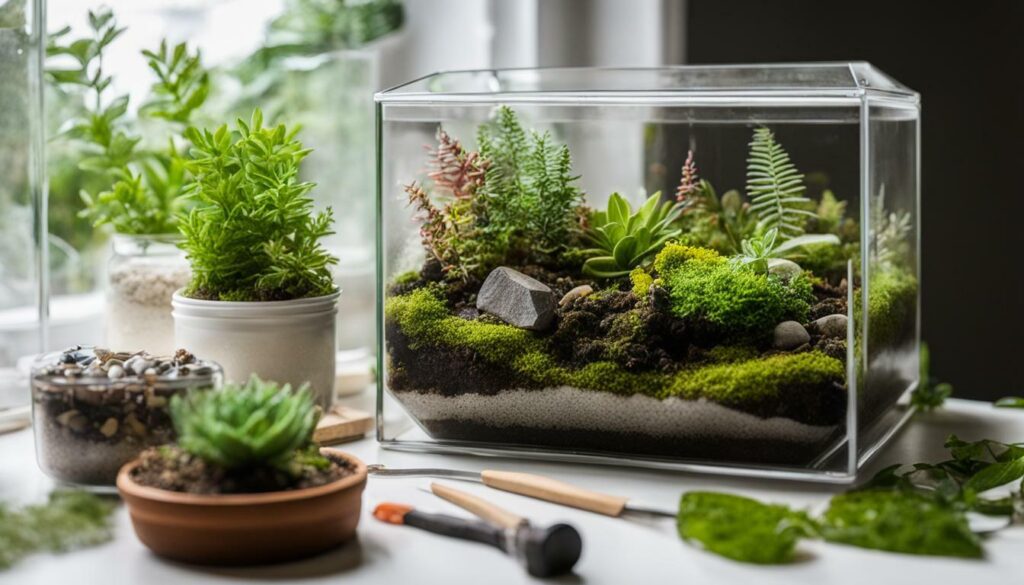
Choosing the right decorations is crucial for complementing the beauty of your terrarium. By carefully selecting the right pieces, you can create a stunning and visually appealing mini-ecosystem. Here are some tips and ideas to help you choose the perfect decorations for your terrarium:
- Consider the size: Opt for small decorations that won’t overwhelm the space or hinder the growth of your plants. Miniature figurines, tiny houses, or even small crystals can add a whimsical touch to your terrarium.
- Think about color and texture: Select decorations that add visual interest and complement the colors and textures of your plants. Vibrant-colored stones, moss, or small dried flowers can create a stunning contrast and enhance the overall aesthetic appeal.
- DIY terrarium decorations: Get creative and make your own decorations using materials like air-dry clay or polymer clay. Sculpt small mushrooms, animals, or abstract shapes to personalize your terrarium and make it truly unique.
- Consider the theme: Decide on a theme for your terrarium and choose decorations that align with it. For a tropical-themed terrarium, you can incorporate seashells, mini palm trees, or small tropical animals.
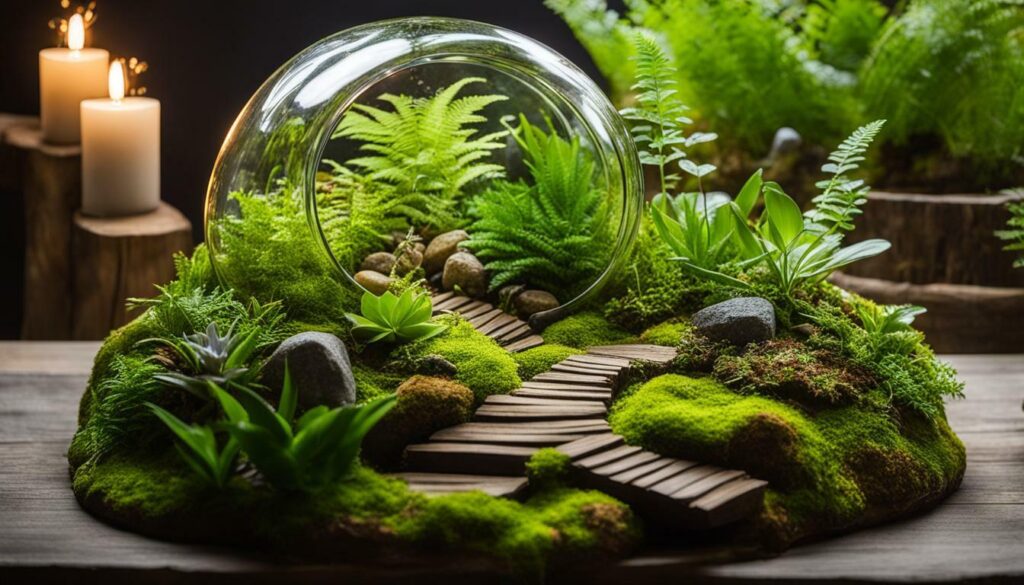
Remember, the key is to create a harmonious and balanced visual composition within your terrarium. Avoid overcrowding the space and allow room for your plants to thrive. By following these tips and ideas, you’ll be able to create a beautifully decorated terrarium that brings joy and tranquility to your space.
Source
“Choosing the right decorations is crucial for complementing the beauty of your terrarium.”
| Decoration Tips | Ideas |
|---|---|
| Consider the size | Miniature figurines, tiny houses, small crystals |
| Think about color and texture | Vibrant-colored stones, moss, small dried flowers |
| DIY terrarium decorations | Air-dry clay, polymer clay, small mushrooms, animals |
| Consider the theme | Seashells, mini palm trees, small tropical animals |
Maintaining Optimal Environment: Light, Temperature, and Watering
Creating an optimal environment is vital for the overall well-being of your terrarium. Terrariums are sealed glass containers filled with plants and soil, forming a self-contained ecosystem. With minimal upkeep required, they offer unique mental health benefits. When it comes to terrarium maintenance, there are a few key factors to consider: light, temperature, and watering.
Light
Proper lighting is crucial for the growth and vitality of your terrarium plants. Most terrariums thrive in bright, indirect sunlight. Placing your terrarium near a window with filtered sunlight or using artificial grow lights can provide the necessary light for photosynthesis. Avoid placing it in direct sunlight, as this can lead to overheating and damage to the plants.
Temperature
Consistent room temperature is essential for a healthy terrarium environment. Most terrarium plants prefer temperatures between 60°F and 75°F (15°C and 24°C). Avoid placing your terrarium near heating vents or drafts, as extreme temperature fluctuations can stress the plants. Maintaining a stable temperature will ensure the well-being of your terrarium ecosystem.
Watering
Proper watering is crucial for the success of your terrarium. Overwatering can lead to root rot and mold growth, while underwatering can cause dehydration and wilting. The frequency of watering depends on factors such as plant species, container size, and humidity levels. Generally, it is best to water sparingly and allow the top layer of soil to dry out slightly between waterings. Use a spray bottle or watering can with a narrow spout to avoid overwatering and to target the base of the plants.
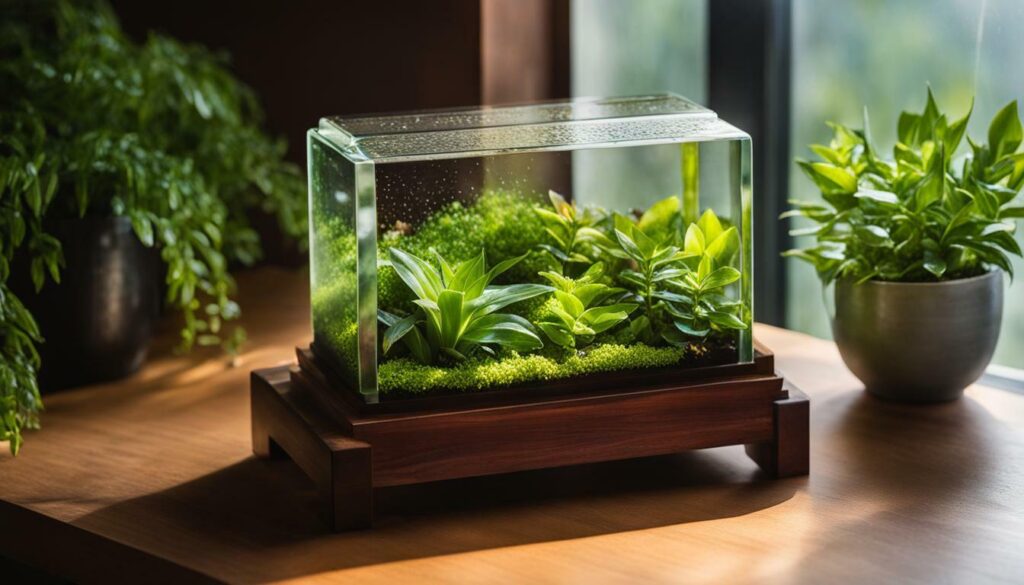
By maintaining the optimal environment for your terrarium, you can ensure the longevity and vibrancy of your mini eco-system. The right balance of light, temperature, and watering will create a thriving habitat for your terrarium plants. Regular monitoring and adjustments will help you achieve the perfect conditions for a healthy and visually appealing terrarium.
Trim and Prune: Keeping Your Terrarium in Shape
Regular maintenance, such as trimming and pruning, is necessary for keeping your terrarium in shape. This ensures the plants remain healthy, encourages new growth, and maintains the overall aesthetic appeal of your miniature ecosystem.
When it comes to trimming plants in your terrarium, it’s important to remove any foliage that is touching the sides of the glass. This not only helps to prevent the growth from becoming congested, but it also ensures proper airflow within the enclosure. Use clean, sharp scissors or pruning shears to carefully trim away any overgrown branches or leaves.
In addition to trimming, pruning is another essential aspect of terrarium maintenance. Pruning helps to control the size and shape of the plants, prevents them from becoming leggy or straggly, and promotes bushier growth. Trim back any long stems or branches that are disrupting the overall balance of the terrarium. This will help to maintain a compact and visually appealing arrangement.
Lastly, it’s crucial to promptly remove any moldy or decaying plants from your terrarium. Mold can spread quickly within the enclosed environment and pose a risk to the health of the other plants. Regularly inspect your terrarium for any signs of mold or rot, and gently remove any affected plants using clean tweezers or tongs. This will help to maintain a clean and thriving terrarium.
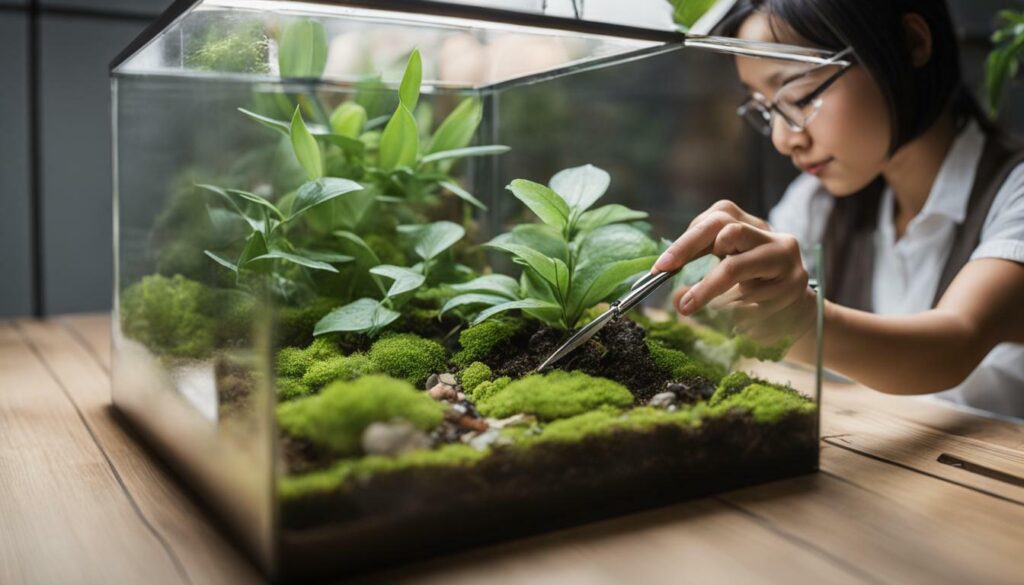
| Trimming and Pruning Tips: | Benefits: |
|---|---|
| Use clean, sharp scissors or pruning shears | Ensures a clean cut and minimizes damage to the plant |
| Remove foliage touching the sides of the glass | Prevents congestion and allows for proper airflow |
| Trim back long stems or branches | Controls the size and shape of the plants |
| Promptly remove moldy or decaying plants | Prevents the spread of mold and maintains a healthy terrarium |
Cleaning the Terrarium Glass: Tips and Techniques
Maintaining clean glass is essential for the visual appeal and health of your terrarium. Over time, dust and mineral deposits can accumulate on the glass, obstructing the view of your plants and reducing the amount of light that reaches them. To keep your terrarium looking its best, here are some tips and techniques for cleaning the glass.
- Gather the right supplies: Before cleaning your terrarium glass, make sure you have the necessary supplies. A soft, lint-free cloth or sponge, warm water, and mild dish soap are typically sufficient for most cleaning purposes. Avoid using harsh chemicals or abrasive materials, as they can damage the glass or harm your plants.
- Remove debris: Start by gently removing any debris or loose dirt from the glass. Use a soft brush or cloth to wipe away any residue, taking care not to scratch the glass surface. This step will make the cleaning process easier and more effective.
- Clean with care: Dilute a small amount of mild dish soap in warm water and moisten your cloth or sponge. Gently wipe the glass, using circular motions to remove dirt and grime. Rinse the cloth or sponge frequently to avoid spreading dirt around.
- Dry with a gentle touch: After cleaning, use a dry, lint-free cloth to remove any excess moisture from the glass. This will help prevent streaks and water spots, leaving your terrarium with a sparkling finish. Take your time and ensure that the glass is completely dry before placing it back in your terrarium.
Regular cleaning of the terrarium glass will not only enhance the visual appeal of your mini eco-system but also promote the health and growth of your plants. By following these tips and techniques, you can maintain a clear and inviting view of your terrarium for your own enjoyment and the enjoyment of others.
Proper cleaning of the terrarium glass is essential for maintaining a healthy environment for your plants. It allows maximum light penetration, helps prevent the accumulation of dust and mineral deposits, and ensures an unobstructed view of your beautiful greenery.
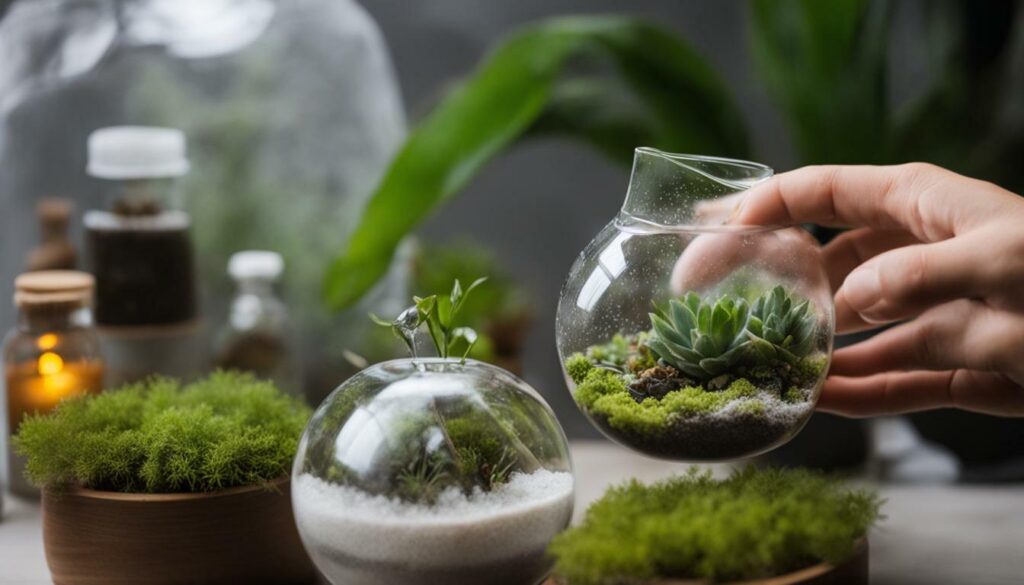
Table: Cleaning Supplies for Terrariums
| Supplies | Description |
|---|---|
| Soft, lint-free cloth or sponge | Use these to gently wipe the glass and remove dirt. |
| Warm water | Moisten the cloth or sponge with warm water for effective cleaning. |
| Mild dish soap | Dilute a small amount of dish soap in warm water for cleaning. |
| Soft brush | Use a soft brush to remove debris and loose dirt from the glass. |
Fertilizing with Caution: Proper Nutrient Balance
Proper nutrient balance is crucial for the well-being of your terrarium plants. While fertilizing can promote growth and enhance the overall health of the ecosystem, over-fertilizing can have detrimental effects. Excess nutrients can lead to an imbalance in the delicate ecosystem, causing rapid plant growth, nutrient burn, and even the death of your beloved plants.
To avoid over-fertilizing, it is important to choose suitable plants that have moderate nutrient requirements. Consider the moisture and light requirements of each plant to ensure they thrive in the terrarium environment. Slow-release fertilizers are ideal for terrariums as they provide a steady supply of nutrients over time, preventing sudden spikes that could harm the plants.
“Proper nutrient balance is crucial for the well-being of your terrarium plants.”
Remember to follow the instructions of the fertilizer manufacturer and be cautious not to exceed the recommended dosage. It is always better to under-fertilize than over-fertilize, as the latter can have irreversible consequences for the delicate ecosystem inside your terrarium.
| Fertilizing Tips: |
|---|
| Choose plants with moderate nutrient requirements |
| Use slow-release fertilizers for a steady nutrient supply |
| Follow the instructions of the fertilizer manufacturer |
| Under-fertilize rather than over-fertilize |
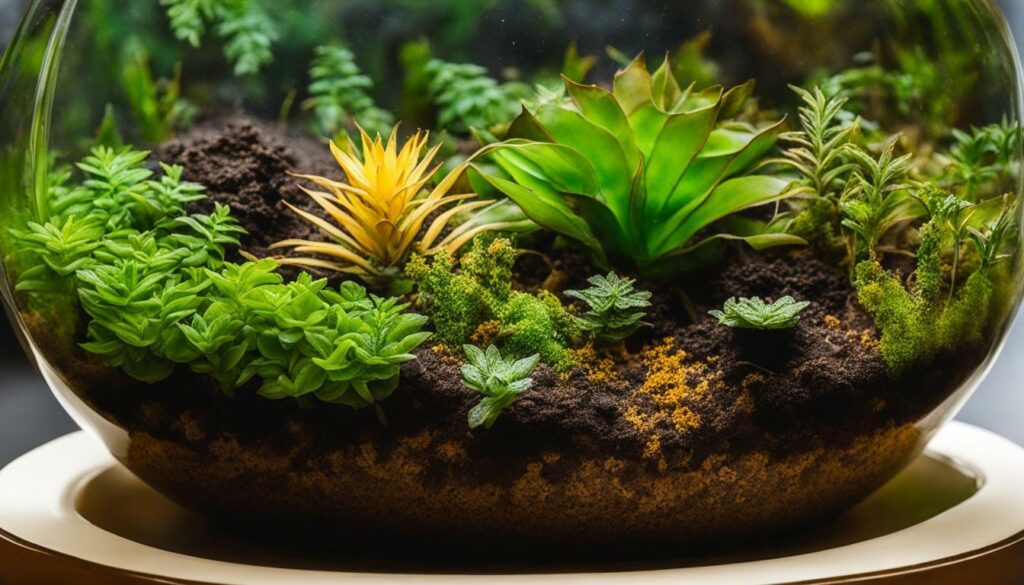
Take a moment to appreciate the beauty of your well-balanced terrarium…
Creating a thriving and beautiful terrarium requires patience and attention to detail. By maintaining a proper nutrient balance, you can ensure the longevity and health of your mini eco-system. Remember to monitor your plants regularly, observing any signs of nutrient deficiency or excess. With proper care and fertilizing caution, your terrarium will flourish, bringing joy and tranquility to your space.
Terrariums with Succulents: Special Considerations
Terrariums with succulents require specific considerations to thrive in their unique environment. Succulents are known for their ability to store water in their leaves, stems, and roots, making them well-suited for arid climates. However, when placed in a sealed terrarium, the lack of airflow can create excess moisture, leading to root rot and other issues.
To ensure the health and longevity of succulents in a terrarium, it’s crucial to provide proper airflow. Leaving the terrarium uncovered allows for better ventilation and helps prevent the buildup of excess moisture. This can be achieved by removing the lid or using a terrarium design that incorporates a mesh or other breathable cover.
Additionally, when selecting succulents for a terrarium, it’s important to choose species that are adaptable to lower light conditions. Succulents that thrive in bright, direct sunlight may not fare well in the filtered light within a terrarium. Opt for varieties such as Haworthia, Echeveria, or Crassula, which are better suited for lower light levels.
Remember to monitor the moisture levels within the terrarium. Succulents prefer well-draining soil, so avoid overwatering to prevent root rot. Allow the soil to dry out between waterings, and be cautious not to let water accumulate at the bottom of the terrarium.
| Succulent Selection Tips: |
|---|
| Choose succulents adaptable to lower light conditions. |
| Monitor moisture levels and avoid overwatering. |
| Provide proper airflow by leaving the terrarium uncovered or using a breathable cover. |
“Succulents add a unique and vibrant touch to terrariums, but their care requirements differ from other plants. Providing adequate airflow and selecting suitable species will ensure their health and longevity within the terrarium environment.”
Example Image:
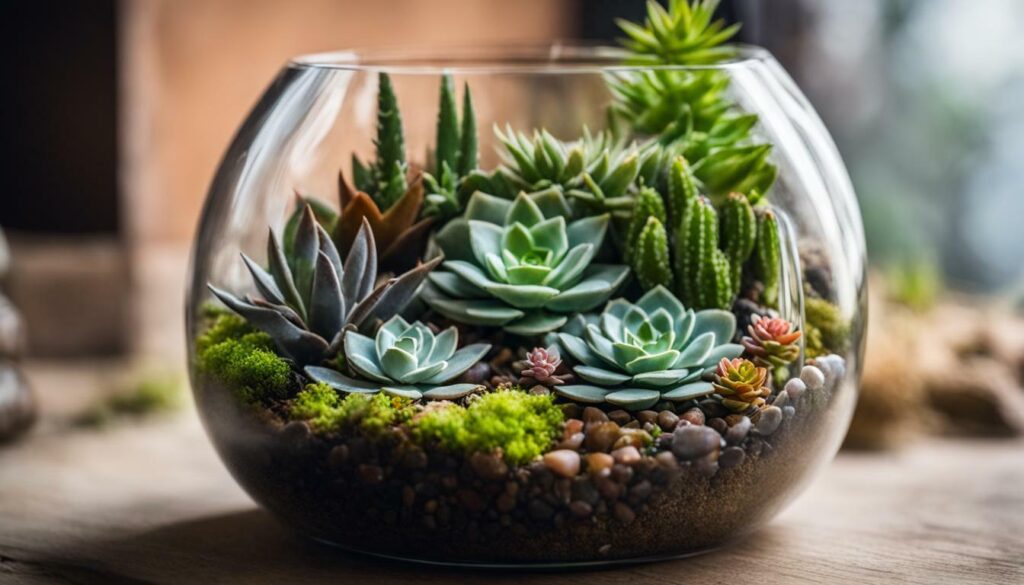
Terrariums with succulents offer a beautiful and low-maintenance way to showcase these resilient plants. By following the special considerations outlined above, you can create a thriving mini desert landscape within the confines of a terrarium.
Troubleshooting Common Terrarium Issues
Despite their low maintenance nature, terrariums can face occasional challenges that require proper care and attention. Understanding and addressing these common issues promptly will help ensure the long-term health and vitality of your mini eco-system. Here are some troubleshooting tips to help you overcome common terrarium problems:
Poor Drainage
One common issue faced by terrarium owners is poor drainage, which can lead to waterlogged soil and root rot. To prevent this, ensure that your terrarium has a layer of gravel at the bottom to create a drainage system. This will allow excess water to flow out, preventing the roots from sitting in water for extended periods. Additionally, avoid overwatering your terrarium and monitor the moisture levels regularly to maintain a healthy balance.
Yellowing or Wilting Plants
If you notice your terrarium plants turning yellow or wilting, it may be a sign of overwatering or insufficient light. Adjust the watering frequency and amount accordingly, allowing the soil to dry out between watering sessions. Additionally, ensure that your terrarium receives the appropriate amount of bright, indirect sunlight. Moving the terrarium to a slightly brighter location can help rejuvenate the plants and promote healthy growth.
Mold and Fungus Growth
Mold and fungus growth can occur in terrariums with excessive moisture and poor airflow. To combat this issue, increase airflow by partially opening the terrarium lid for a few hours each day. This will help reduce the humidity level inside the terrarium and discourage mold and fungus growth. Additionally, remove any moldy or decaying plant material promptly to prevent further contamination and maintain a clean and healthy environment.
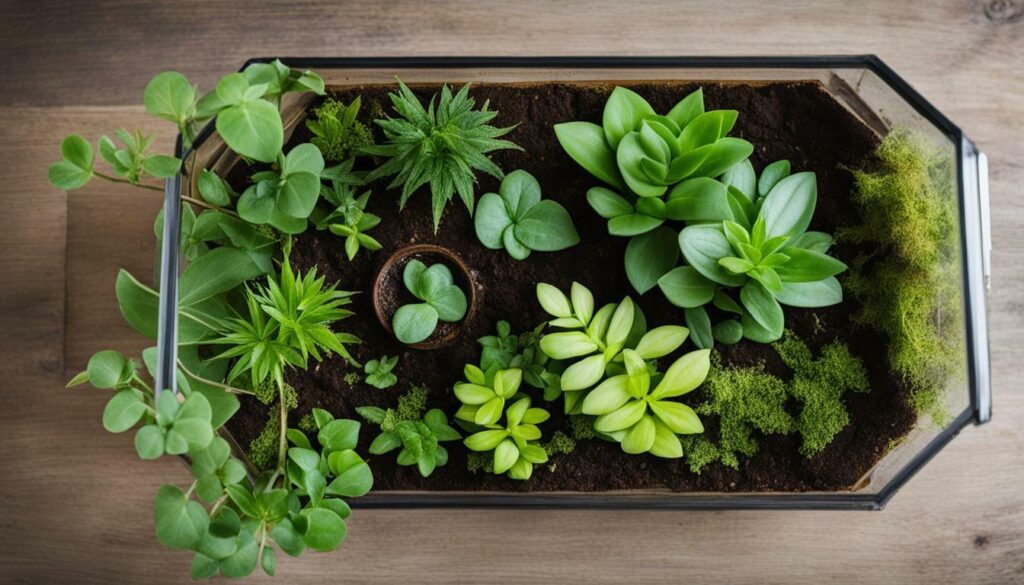
| Issue | Troubleshooting Tip |
|---|---|
| Poor Drainage | Ensure a layer of gravel at the bottom for proper drainage |
| Yellowing or Wilting Plants | Adjust watering and provide adequate light |
| Mold and Fungus Growth | Increase airflow and remove moldy plant material |
By addressing these common terrarium issues promptly and implementing the recommended troubleshooting tips, you can maintain a vibrant and thriving terrarium. Regular monitoring and care will help you enjoy the beauty and benefits of your mini eco-system for years to come.
What Are the Best Decorations for Terrariums and How Should They Be Cleaned?
When it comes to terrarium care cleaning techniques, it’s important to choose decorations that can withstand frequent cleaning. Opt for durable materials such as smooth stones, plastic figurines, or glass ornaments. To clean, gently wipe the decorations with a soft cloth or brush to remove dust and debris.
Enhancing Your Terrarium Experience: Tips and Tricks
Elevate your terrarium care routine with these expert tips and tricks. Taking proper care of your terrarium will ensure that it thrives and remains a beautiful mini eco-system in your home. Here are some valuable insights to help you enhance your terrarium experience:
1. Choose the Right Plants
When selecting plants for your terrarium, it is important to choose small, slow-growing plants that thrive in a humid environment. Look for plants with vibrant colors and textures to create an eye-catching display. Some popular choices include ferns, mosses, and fittonias. Remember to research the specific care requirements of each plant to ensure they are compatible with your terrarium’s conditions.
2. Find the Perfect Spot
Placing your terrarium in the right spot is crucial for its success. Terrariums require bright, indirect sunlight to thrive. Avoid placing them in direct sunlight, as this can cause excessive heat and damage the plants. Look for a location in your home that receives bright, filtered light throughout the day. Additionally, maintaining a consistent room temperature will help create an optimal environment for your terrarium.
3. Water with Care
Proper watering is essential for the health of your terrarium. Overwatering can lead to root rot and mold, while underwatering can cause the plants to wither. Use a spray bottle or a watering can with a narrow spout to gently moisten the soil without overdoing it. Check the moisture level of the soil regularly and adjust your watering schedule accordingly. Remember, it’s always better to underwater than to overwater your terrarium.
Elevate your terrarium care routine with these expert tips and tricks. By choosing the right plants, finding the perfect spot for your terrarium, and watering with care, you can create a thriving and visually stunning mini eco-system in your home. Follow these guidelines and watch your terrarium flourish!
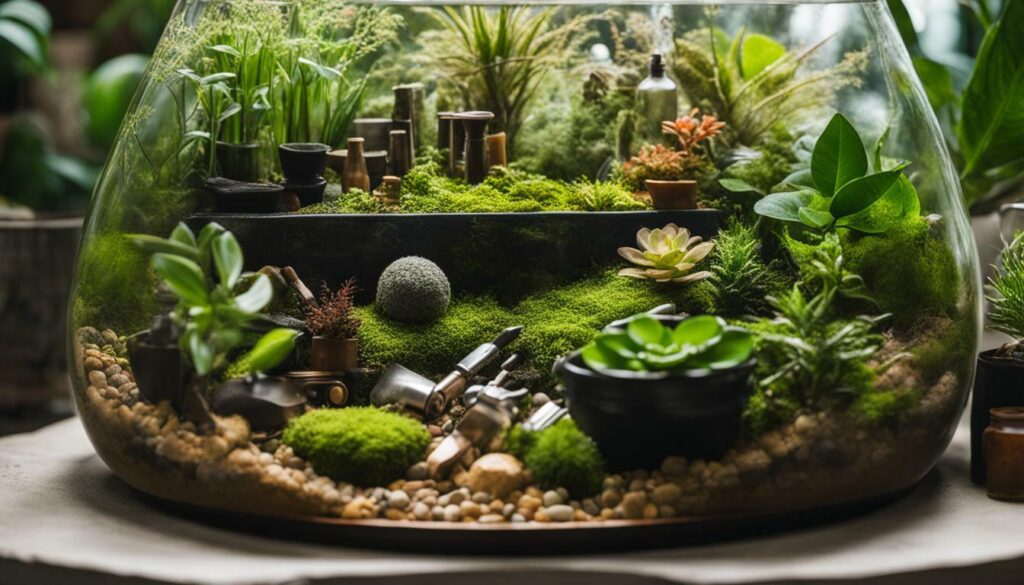
Proper terrarium care and cleaning are essential for creating and sustaining a thriving mini eco-system. Terrariums, sealed glass containers filled with plants and soil, offer a unique way to bring the beauty of nature indoors while providing numerous mental health benefits. To ensure the success of your terrarium, it is important to follow a few key steps.
Building the perfect terrarium
Start by creating a proper soil base with layers of gravel, charcoal, and moist soil. This will provide the necessary drainage and nutrients for your plants to thrive. When choosing plants, opt for small, slow-growing varieties that enjoy high humidity and feature vibrant colors and textures. These will create a visually appealing and balanced ecosystem within your terrarium.
Maintaining the optimal environment
Place your terrarium in a location with bright, indirect sunlight. This will ensure that your plants receive the right amount of light without being exposed to harsh direct sunlight. Additionally, maintaining a consistent room temperature is crucial for the well-being of your terrarium. Avoid extreme temperature fluctuations that can stress or harm your plants.
Cleaning, trimming, and fertilizing
To keep your terrarium looking its best, regular cleaning of the glass is necessary to prevent light restriction. Use a damp cloth to gently wipe away any dust or dirt. When trimming your plants, remove any foliage that is touching the sides of the terrarium to maintain proper airflow. Prune any straggly stems and promptly remove any moldy plants to prevent the spread of disease. When fertilizing, be cautious not to overdo it, as excess nutrients can harm your terrarium. Choose plants that have similar moisture and light requirements to ensure they thrive in your terrarium environment.
Succulent terrariums
If you choose to create a terrarium with succulent plants, keep in mind that they have different care requirements. Succulents prefer drier conditions and require proper airflow, so it is important to leave the terrarium uncovered to allow for ventilation. The combination of succulents and terrariums can create a stunning display but requires careful consideration of their specific needs.
By following these guidelines and regularly caring for and cleaning your terrarium, you can enjoy the beauty and tranquility of a self-sustaining ecosystem right in your own home. So go ahead, embrace the world of terrariums, and experience the joy of nurturing nature in a miniature form.
FAQ
What is a terrarium?
A terrarium is a sealed glass container filled with plants and soil, creating a self-contained ecosystem.
What are the benefits of having a terrarium?
Terrariums require little upkeep and offer unique mental health benefits.
How do I prepare a terrarium?
Start by building a soil base with layers of gravel, charcoal, and moist soil.
What kind of plants should I choose for my terrarium?
Select small, slow-growing plants that thrive in humidity and have vibrant colors and textures.
Where should I place my terrarium?
Terrariums should be placed in bright, indirect sunlight and kept at a consistent room temperature.
How often should I water my terrarium?
Proper watering is essential, but be careful not to overwater as it can lead to rot and mold.
How should I trim and prune my terrarium plants?
Remove any foliage touching the sides, prune straggly stems, and promptly remove any moldy plants.
How do I clean the glass of my terrarium?
Regularly clean the terrarium glass with a damp cloth to prevent light restriction.
Can I fertilize my terrarium plants?
Avoid over-fertilizing terrarium plants and choose suitable plants based on their moisture and light requirements.
Can I include succulents in my terrarium?
If using succulents, leave the terrarium uncovered to ensure proper airflow.

